This is a Kiev 4 (Type 3) rangefinder camera made by Kiev Arsenal in Kiev, Ukraine, which at the time was part of the Soviet Union. Today, there is a whole sub-genre of cameras made in the Former Soviet Union which are popular with collectors. The common brand names were FED, Zorki, Zenit, Leningrad, and Kiev. These cameras are known collectively as FSU cameras and all of them except the Leningrad were either exact replicas or very similar to well established German brands like Contax and Leica. I could type an entire article about the deep history of FSU cameras, but for now, I’ll stick with my Kiev 4 which was made in 1970. Kiev cameras and lenses are very easy to date as the first two digits of their serial numbers are the year in which they were made.
Film Type: 135 (35mm)
Lens: 50mm f/2 coated Jupiter 8M 6 elements
Focus: 0.9m to Infinity
Type: Coupled Rangefinder
Shutter: Vertical Metal “garage door” Focal Plane
Speeds: B, 1/2 – 1/1250 seconds
Exposure Meter: Selenium Light Meter
Battery: None
Flash Mount: Coldshoe and PC Sync
Manual: http://www.butkus.org/chinon/russian/kiev-4/kieva-a-splash.htm
History
This camera is called the Kiev 4 and it was preceded by the Kiev 3 and 2. Although there was no Kiev 1, the Kiev itself is an almost exact replica of the German made Zeiss-Ikon Contax II and III which were originally introduced in 1936.
The Contax II and III cameras were a very popular and well designed all-metal 35mm rangefinder camera made by Zeiss-Ikon in Dresden, Germany. The Contax line of cameras were designed to directly compete with Leica cameras which were also very popular at the time. When it was first released, the Contax II was the first camera to ever have a shutter speed of 1/1250, and it was also the very first rangefinder to combine both the rangefinder and viewfinders in the same window. The Contax had a unique rangefinder that separated the viewfinder and rangefinder windows by a wider distance than on other cameras. By having the two windows farther apart, the focusing was more accurate. Both Leica and Contax cameras were considered by many to be the best cameras in the world at the time, and to this very day, fetch extremely high resale values in the collector market.
By their very nature, cameras are precision instruments which require excellent manufacturing capabilities, and as a result when World War II started, many camera companies turned their expertise into making machinery for the war effort. When WWII was over and Germany was split into West and East Germany, the Soviet Union “acquired” all of the manufacturing technology that was made in East Germany, including the Zeiss-Ikon factories in Dresden.
Although the Soviet Union had some experience making cameras, they had nothing with the quality of the Contax, so they took advantage of their position in East Germany and handed over the manufacturing equipment along with many workers from the Dresden plant and moved them all to the Kiev Arsenal factory in Kiev, Ukraine. The Kiev Arsenal factory had been around since 1764 where they made all kinds of things for the war effort so they already had an expertise in manufacturing, just not anything as specialized as a camera.
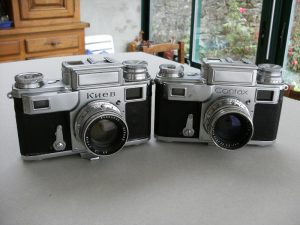
Once the Contax equipment was setup and the workers were trained, Kiev Arsenal rebranded the Contax II and III and began selling them as the Kiev 2 and 3. The Kiev 2 was like the Contax II in that it did not have a lightmeter, whereas the Kiev 3 and Contax III did. These original Kievs were exact replicas and very little was different from their German counterparts. It wasn’t until the line of Kiev 4s and their associated variants that the Kiev cameras started to change from the original German designs. Although the Kiev 4 varied from the earlier Kiev 2s and 3s, they physically look very similar. You can look at a 1930s era Contax II and a 1980s era Kiev 4M, and although there were many changes, a lot of the same design elements remain.
The entire line of Kiev 2, 3, and 4 cameras were made from 1947 – 1987. This encompasses almost the entire existence of the USSR after WWII and the fall of the Soviet Union in 1991. The Kiev 4 was the last major revision of the original Contax camera and it came in many sub-variants. There was another camera called the Kiev 5 which was an attempt to significantly redesign the Kiev camera, but it was not successful and is so different from the Kiev 2, 3, and 4, I consider it to be a completely different model.
Within the Kiev 4 family of cameras, most came with a selenium light meter on top, but some did not. Models that had or did not have a light meter were sold concurrently. The models that do not have the light meter are called the Kiev 4A. Selenium light meters eventually lose their ability to detect light and are difficult to repair, so even when you find a Kiev 4 with a light meter with a moving needle, its highly likely it is not accurate. Because of this, some collectors prefer the 4A to the 4 because of its sleeker design.
The model I have is considered to be a Type 3 Kiev 4. In total, there are 4 “types” of Kiev 4s. These 4 types weren’t officially marketed by Kiev Arsenal, they are merely design changes that occurred throughout the life cycle of the Kiev 4. The Kiev 4 was made from 1957 – 1980, and the type 3 variant was made from 1958 – 1974 (some sources say 1975). Further complicating matters is that often, you can find Kiev cameras that have characteristics of more than one type. At a glance, a Type 3 Kiev 4 is very easy to distinguish from a Type 4 because the Type 3 has an all-metal self timer lever and a soft leather skin. Starting with the Type 4, the self timer lever had a plastic tip, and the leather skin was replaced by a pebbled vinyl leatherette.

In 1976, a new type of Kiev 4 was released called the Kiev 4M that had several design changes such as a completely redesigned film speed knob, film advance/rewind knob, and a new lens. The 4M was also available with and without a light meter. Models without the light meter were called the 4AM. The 4M and 4AM were made until 1987.
It has been said that the Kiev cameras made through the end of the 1960s were done with the original machinery from the Dresden plant. Many of the same workers and technicians continued working on the Kiev cameras throughout this time. By the 1970s, many of the workers had retired, and younger, less experienced workers took their place. In addition, many of the original machines that made the optics for the cameras had worn out and needed to be replaced. As a result quality control started to drop off in the later models. I read one article that said by the early 80s, so many Kievs were coming out of the factory broken, that people had to buy a camera and immediately take it in for repair before they could even use it.
That isn’t to say that all Kievs from the 70s or 80s are garbage, but the quality became very inconsistent and as such, are less desirable. Mine, being made in 1970 came at the very end of the “desirable” area, and I chose mine because it had received a full CLA from a reputable seller in Ukraine.
Another fault of the old Kievs is that the oil that was used to lubricate the insides of the camera was of a poor quality and over the course of time would eventually turn into a sticky goo. Many surviving Kievs, even those made in the desirable era, have shutter speeds that are way off, or focus mechanisms that are very hard to move. As a result, many of these old Kievs need a full CLA where the old oil can be cleaned and replaced with a new lubricant. After an old Kiev receives a CLA, it is often in as good, or even better condition than the day it came out of the factory.
Today, the Kiev 4 is still a very popular camera on the collector’s market. Most of them came with the Jupiter 8 lens which was a 50mm f/2 lens which was based off the original Contax lens made by Zeiss-Ikon. To this very day, Carl Zeiss lenses are still made and are still considered to be some of the best out there. A Kiev 4 in good working order with a clean Jupiter 8 lens is capable of very high quality shots, rivaling even the best digital cameras today.
If you take the Kiev 4’s capability of very high quality images, combined with the wide rangefinder window, well built metal body, unique design, and interesting history, you have yourself a very cool piece of history that is just as great of a display piece as it is as a working 35mm camera.
My Thoughts
The cool design of the Kiev was enough for me to want to have one in my collection, but add its reputation as a very capable camera and really cool history, it is a must have for me. If you like conversation pieces, it doesn’t get much better than this.
When you hold a Kiev 4, the first thing you notice is how solid it feels. Apart from the glass in the lenses and the viewfinders, and the leather skin, the entire camera is made entirely out of metal. As mentioned above, as long as you get one made before the mid 70s, there isn’t a speck of plastic anywhere to be found. This thing is solid!
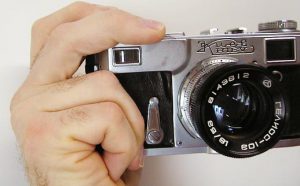
Another cool thing about the Kiev is that it looks and works like no other camera. The rangefinder window is on the far right side of the camera which is where most photographers hold the camera, so its very easy to accidentally cover the rangefinder window with your hand. As a result, you have to hold the camera a little different. This method has the nickname of the “Contax grip” where you put two of your fingers on your right hand on top of the camera and your two other fingers below the self-timer.
The hardest thing to overcome if you are interested in buying a Kiev 4 is that they were primarily sold in the Soviet Union and eastern Europe. Towards the end of its life, some export models were sold in the United States, but you have to wonder how appealing a Communist Camera was in the United States during the peak of the Cold War? As a result, there aren’t many available in the US. You can very easily find these on eBay in Eastern Europe and in FSU countries, but you have to risk buying internationally which isn’t appealing to everyone. Furthermore, it is extremely difficult to find an original condition Kiev that works perfectly without some type of service. If you buy one online, I highly recommend you look for ones that have had a CLA, or at least have been confirmed to be in good working order by a camera technician, but this obviously adds to the cost.
My Results
This is actually my second Kiev 4. The first had a serial number from 1976, and while it was in good condition, it exhibited many of the same problems that are common with old FSU cameras. The slow shutter speeds were WAY off, the rangefinder didn’t work at all, and there were frame spacing problems. I shot one roll of film through it, and only got one truly good picture out of it. Most of the pictures were completely out of focus, had overlapping frames, and had light leaks galore. I found some information online regarding how to repair these cameras, but considering the Kiev is based of a complicated design dating back to the 1930s, it is not a simple camera to repair. Everything I had read indicated that this would need to be corrected by a professional. Sadly, the only true professionals who are still able to work on these cameras are all overseas, so I had to let it go, and I sold it on eBay for more than I paid for it originally.
When I acquired this one, I specifically looked for one that had been serviced by a professional. I found a guy based out of Ukraine who made a living cleaning and servicing old FSU cameras. Apparently these things are still very plentiful in the Fomer Soviet countries that guys make a living out of cleaning them up and reselling them. I had been looking for a Type 3 from the 60s, and it so happened that of all the ones that were available, this one was the best looking one, despite it being from 1970. I figured that since it had been professionally cleaned, lubed, and adjusted, any negative mojo of it being from 1970 would be offset.
When the camera arrived, I used my prior knowledge from my first Kiev and did an inspection, and I was amazed at how different they handled. Everything on the new one moved so smoothly. The shutter speeds were all accurate, and easy to set. While I don’t have experience with every type of FSU camera, one consistent characteristic of many of them is that they require a specific order when changing shutter speeds. With the Kiev, you must cock the shutter before changing the shutter speed. There are conflicting reports of the repercussions if you do it out of sequence. Some say it can throw off the timing of the shutter and cause your pictures to be incorrectly exposed, some say it causes damage to the camera, some say it makes no difference at all. Whatever the case, it seems to be more of an issue at the slower shutter speeds. Apparently the Kiev 4 has a unique system of levers and springs that engage at 1/25 and 1/10 of a second to slow down the shutter for longer exposures. In my opinion, these old cameras work best outdoors in good lighting, so I normally keep the shutter speeds at 1/50 and above.
The viewfinder is large and bright and makes focusing a snap. As mentioned earlier, the rangefinder window is on the far right side of the camera, which positions it near the photographer’s right hand. This requires that you position your fingers away from the window, or else you will block the window. Once you have aligned the image in the rangefinder, your shot is in focus, and you can move your fingers to anywhere you wish.
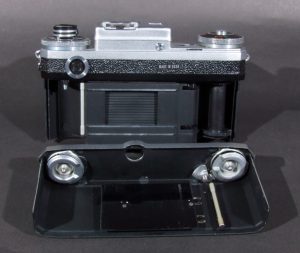
Loading the film requires removal of the entire back of the camera. There are two circular latches on the bottom of the camera that must be pulled out and rotated 180 degrees. After doing this to both sides, the entire back and bottom of the camera can be removed.
All but the later Kiev 4s had a removable film takeup spool which could be removed to ease installation of the film. The downside to this, of course, is that the takeup spool could be easily lost. This is another consideration to make when purchasing a Kiev 4. If yours had a removable spool (most did), you will want to make sure one is included.
When installing the new roll of film, you thread the header of the film into the takeup spool first, and then install the spool into the right side of the camera. Next, you pull out the rewind knob and insert the film cartridge into the left side of the film compartment. Once everything is connected, you reinstall the back of the camera, rotate both latches and fold them back down. Like most other cameras of the era, you have to advance the film two complete shutter rotations to get the film ready for frame 0.
I really like this camera, especially now that I have one that’s in good working condition. I love the heavy metal feel of it in my hands. Its well built and has a very solid feel. The Jupiter 8 lens is capable of extremely nice shots. The rangefinder works wonderfully and makes it very easy to focus, even in low light. I would argue that the Kiev 4 is easier to focus in low light than most manual focus SLRs of the 60s, 70s, and 80s. Although it is harder to find an example in good condition in the United States, its absolutely worth the price to have one imported from overseas with a full CLA. I would guess that as the years go by and supplies dry up, the prices on these cameras will most likely skyrocket.
Additional Resources
http://en.wikipedia.org/wiki/Kiev_(brand)
http://mattsclassiccameras.com/kiev_4.html
https://camerajunky.wordpress.com/2012/01/02/kiev-4/
http://www.commiecameras.com/sov/35mmrangefindercameras/cameras/kiev/index.htm
http://www.sovietcams.com/index.php?-1887505578
http://camerapedia.wikia.com/wiki/Kiev_4
http://www.photoethnography.com/ClassicCameras/index-frameset.html?Kiev4a.html~mainFrame
http://www3.telus.net/public/rpnchbck/
https://www.flickr.com/groups/kiev4/

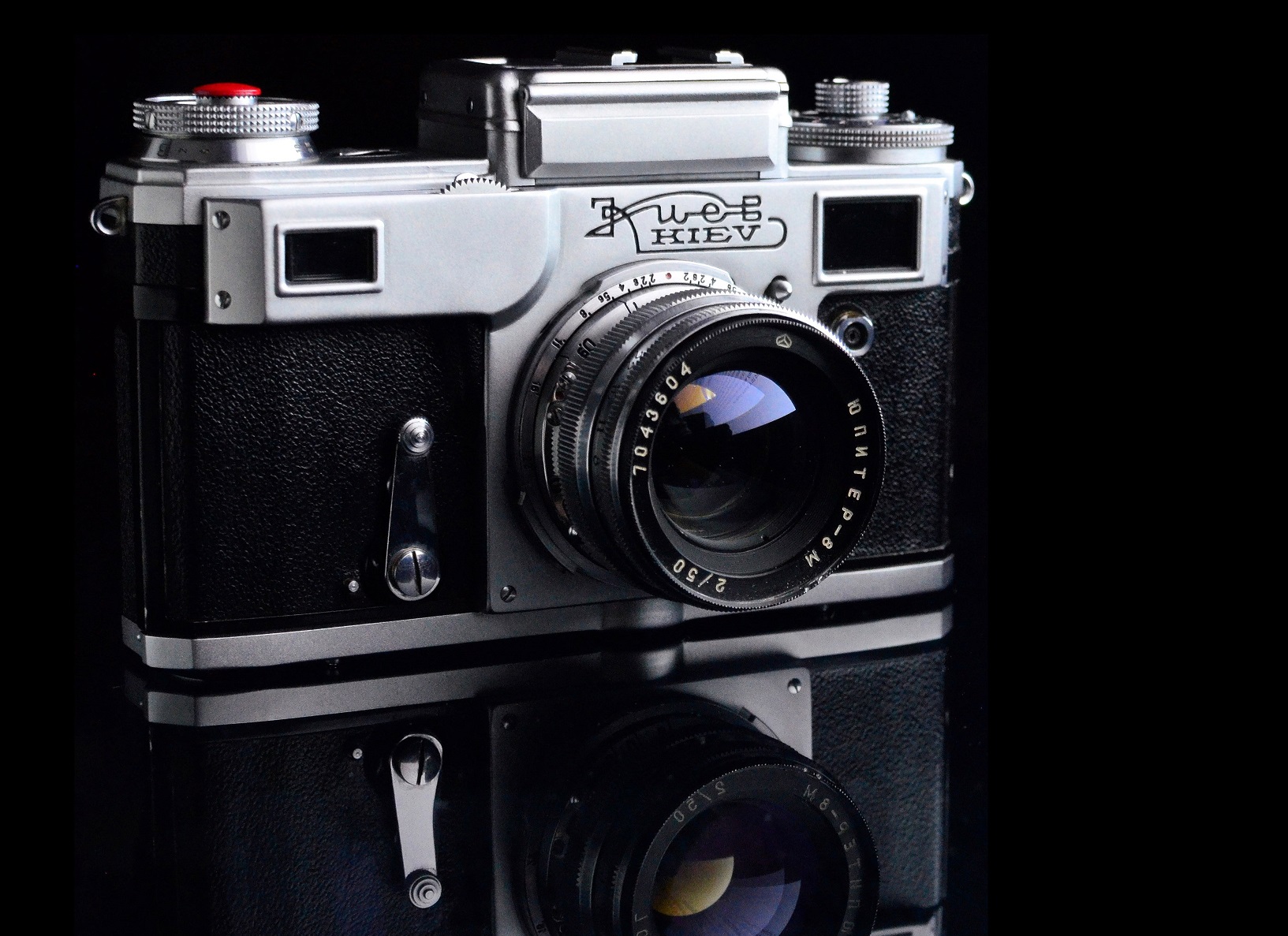

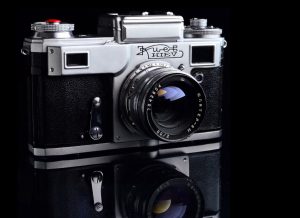












Mike,
I’m interested in the Kiev 4. Great article.
Would you mind sending me the name of the Ukraine guy who does Kiev cameras? I’d like to try to purchase from him.
Thanks.
Richard
What a great article, I have a type 3 Keiv 4, I’ve been trying to identify this camera all day and to read the history of these cameras was amazing Thank you!!. From my research I think I have identified mine as being from 1960 (thanks to your tip at the beginning of your post). My camera belonged to my late fathers vintage and antique camera collection, he was a collector for over 50 years. Thanks again!!
Can you share who is the seller you bought your 2nd kiev 4?
I’m sorry, I bought this camera several years ago, I do not remember who I bought it from.
Website that camera was most likely purchased from is: OKvintagecamera.com He has tons of soviet cameras and I’ve purchased two that work perfectly!
Check “grizzly33bear” who sells out of Ukraine on eBay. He’s been active at least ten years, and seems to have an unlimited supply of minty black Olympic logo Kiev 4 and 4M (unmetered) cameras available.
Great article and review. Thanks for that. I got what I believe is a Kiev 4AM a couple of years ago after see Asteroid City and subsequently obsessing about the Mountaineer. Now I’m obsessing over shooting only Ukrainian film through it (via the folks at FPP)!